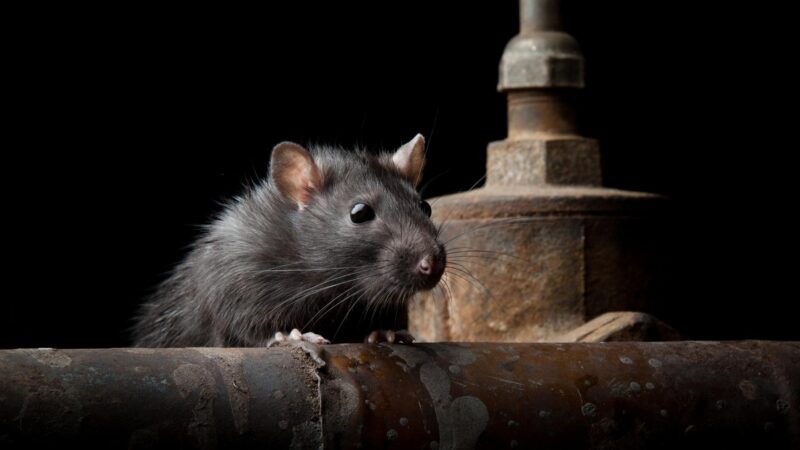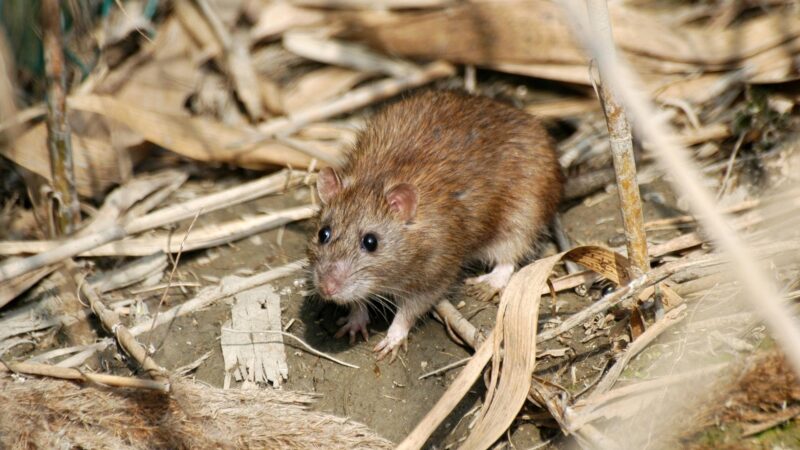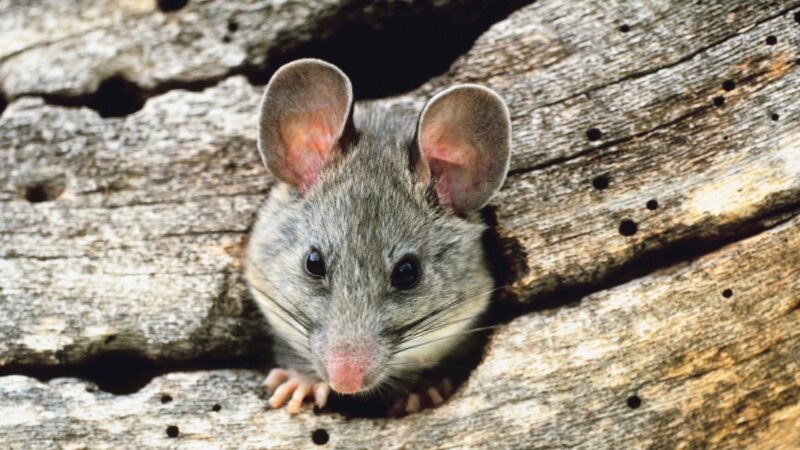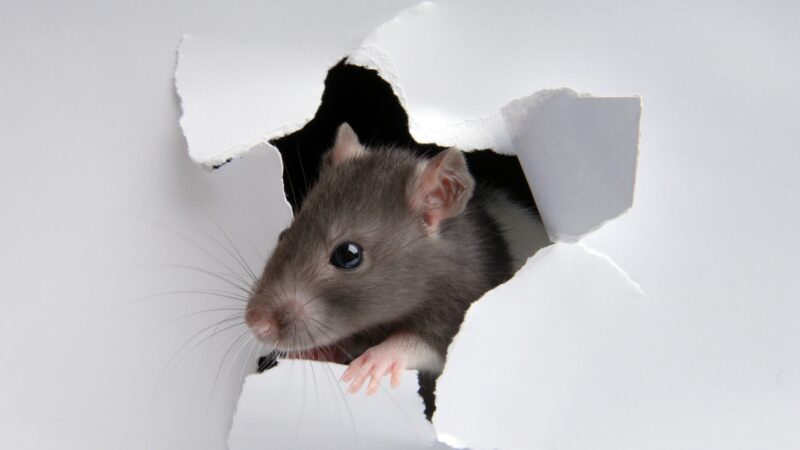Rat holes or rat burrows are nests of rat species that live in lower elevations. In most cases, these rat nests are close to their food source.
If they are near or within your property, chances are rats will be entering your house. But before taking any action, you should make sure that these holes are really rat holes.
What do rat holes look like? Rat holes look like ordinary holes in the ground and are usually found in sandy soil, under bushes, and near houses. Rat holes come in a variety of sizes, from tiny openings the size of pencils to bigger ones with a diameter of several inches. They use these holes to escape quickly once they sense danger.
Rats are smart creatures, and they know how to hide from predators. Many of us consider them nuisances and dangerous, while some treat them as pets. Digging holes underground is one of their interesting characteristics.
This article explains everything about rat holes underground and how to deal with them.
Where Do Rats Live?

Rats may live in higher places or under the ground, depending on the species. The two most common rat species in the United States are roof rats and Norway rats.
Also sometimes called black rats, roof rats usually live in attics and trees. On the other hand, Norway rats (also called brown rats) live in burrows.
Do Rats Live Underground?
Rats live underground, but not all of them. Scientifically known as Rattus norvegicus, Norway rats dig holes in the ground and use them as nests. These rat holes can be interconnected via long tunnels.
Nonetheless, brown rats may also invade a house or building and are very likely to live in the basement.
Do Rats Dig Tunnels?
Rats (particularly Norway rats) dig tunnels, which are a part of their nest and are usually lead to their safety exits. These tunnels are about 3 feet long, but rats can make it longer, depending on how far their nests are to their food source. They can also be found near outdoor trash cans and other dry areas.
What Is a Rat Hole?
Rats dig holes or passageways to get to their dens and tunnels, which are known as rat holes. Rat holes come in a variety of sizes, from tiny openings the size of pencils to bigger ones with a diameter of several inches.
Although some may be trapezoidal or rectangular, rat holes are typically oval or circular in shape. Identifying the existence of rats in your home requires being able to spot rat holes. If you discover any rat nests within your house, you should call a pest control professional right away to get them removed and ensure the rat infestation doesn’t get worse.
What Does a Rat Hole Look Like?
A rat hole has a circular opening of about 2-4 inches in diameter and usually has smooth walls. Active rat holes are likely to have a clean entrance since rats will also eat the debris around them.
Inside, the wall is smooth due to grease marks. They will also have rat feces and urine that produce a very foul ammonia odor.
What Do Rats That Dig Underground Look Like?

As mentioned above, the rat species that dig underground are the Norway rats. Also called sewer rats or brown rats, these burrowing rats are usually reddish-brown and about 400 mm. (15.7 inches) long, including the tail.
They weigh about 3/4 to 1 pound (340-453 grams) and are generally larger than roof rats.
Male Norway rats are usually larger than females. But for both sexes, their tail is about the length of their head and body combined. It is also significantly shorter than the tails of roof rats.
Both their ears and tails have no hair. As pets, Norway rats may be brown, black, or white. They are also excellent swimmers.
Should I Block Up a Rat Hole?
You should block or close a rat hole as soon as possible. Otherwise, rats can populate very quickly and will dig more holes. Blocking rat holes will interrupt the rodent’s normal pattern of going back to its nest.
If you don’t close these holes, they will also be used by raccoons or other rodents such as squirrels.
However, never block a rat hole if there are still rats inside. If you do, the trapped rats will die and will decompose. This will produce a very foul odor, which is not only bad for the health but will also attract pests such as flies.
Instead of trapping rats inside, trap them outside or kill them and dispose of them properly.
Where to Find a Rat Holes?
In addition to landscaping, underground tunnels, and other regions, walls, floors, and ceilings can all have rat holes. Check for a hole with consistent shape or rough sides, as well as little tracks surrounding the hole, to spot a rat hole. Rat droppings found close to the entrance are another sign of rat holes.
Why are Rat Holes and Burrows Dangerous?

Rat holes and burrows are dangerous because they are clear signs that rats are present. These rodents will soon enter your house and will cause damage.
Rats gnaw on almost anything, including paper, books, cardboard boxes, PVC pipes, plastic containers, fabric, and wooden structures such as furniture and cabinets.
Just like other rodents, rats have very sharp teeth that grow endlessly. Because of this, rats need to gnaw on hard materials to wear their teeth down. They can also start a fire once they gnaw on electric cables.
Rats will also destroy food crops outdoors. But worst of all, they contaminate food and spread diseases.
Rats are vectors of zoonotic diseases such as bubonic plague, Hantavirus, leptospirosis, rat-bite fever, rat mite dermatitis, and salmonellosis.
These diseases can be transmitted to humans either through rat bites and scratches or by eating food or drinking water that is contaminated with infected rat droppings.
How Deep Do Rats Burrow?
Most Norway rats dig burrows that are about 18 inches deep. Nonetheless, they may dig deeper if they sense that a food source is nearby.
In doing so, these rats can easily travel below the foundation and concrete stabs of your house. Deeper rat holes also mean that there are already a lot of rats within your property.
How to Inspect and Identify Rat Holes?

Rat holes are close to a porch, a barn, a deck, garbage cans, woodpiles, and foundations around a house or building. These rat nests may be mistaken for ground squirrel burrows.
Aside from the size and appearance, there are other signs that they are indeed rat nests. Here’s how to identify rat holes further:
- The most obvious sign of a rat hole is when there are rats inside. Rats are nocturnal creatures, which means that you can see them resting inside their nest in the daytime.
- There is food debris inside. Rats usually bring food into their nests to feed their young.
- They have visible grease marks on the walls and pathways. These marks are signs that rats have been coming in and out of the hole.
- There are rat feces inside. Norway rat droppings are mostly black and shiny but may vary in color, depending on what the rats are eating. They look like capsules and are about 3/4 inches long.
- There is a very strong ammonia-like smell. Just like other rodents, rats pee anywhere, even inside their nest. Rat urine contains nitrogen that forms into ammonia once it breaks down.
Rats Hole vs. Mouse Hole
Rat Hole
Typically reaching between 1/2 inch and 2 inches in diameter, rat holes are larger than mouse holes. Rats and other rodents can enter and escape buildings via these devices primarily. Rat holes are frequently discovered in attics, garages, and sheds, as well as near a building’s foundation and exterior.
Mouse Holes
Mouse holes range from 1/4 inch to 1 inch in diameter. They are frequently found in basements, kitchens, and other places where mice may be found. They are primarily utilized to let mice access and escape a facility.
How to Get Rid of Rat Holes?

The best way to get rid of rat holes is to block them. But again, you should only do this if all the rats inside are gone, and don’t delay it. Otherwise, it will cause more problems.
Don’t use materials that rats can easily chew, such as paper, foam, plastic, and wood. Here are some effective tips on how to block rat holes:
- Flush the rat holes with water using a garden hose. If there are still rats inside, they will immediately come out.
- If the rats refuse to leave, place some dry ice in the burrow. Dry ice is effective in killing rats instantly. However, dry ice should only be used outdoors, and you must keep it out of the reach of children and pets.
- The grease marks contain pheromones, which rats use to communicate with each other. To remove the rat smell, pour white vinegar on those marks.
- Cover the rat hole with copper mesh wire or steel wool. To prevent rats from trying to remove them, put some pepper powder or use pepper spray.
- For bigger holes, cover them with cement and sand. If you will use metal sheets, make sure rats cannot remove them.
- Make sure all the entrance and exit points are sealed properly.
How to Remove a Rat Nest in Your House?

Aside from burrows, rats may also make nests in trees, attics, and even in cavity walls. These rat nests are usually made of grass, leaves, twigs, fabric, paper, and man-made debris.
Unless the nest belongs to your pet rat, you should get rid of it as early as you can. Here are some useful tips on how to remove a rat nest.
1. Get rid of the rats first.
If you don’t get rid of the rats, they will make a new nest soon. Using traps is the safest and the most effective way to eliminate rats. However, avoid using sticky traps that will cause rats to die slowly in pain.
Instead, use live traps such as Kensizer Humane Rat Trap . For the bait, you can use peanut butter or oatmeal.
- Humane Rat Rodent Trap - After catching them, you can release...
- Light Weight Galvanized Steel - Long-lasting and sturdy, the...
- High sensitive trigger mechanism - Once the trigger is touched,...
- Exclusive Patented Design - Innovative, efficient and easy to...
- Premium Customer Service - If it's damaged in half a year, please...
2. Ventilate the area.
Let fresh air enter and the toxic smell out of the room by opening the door or window. Avoid using an electric fan because it could cause rat poop to spread, and you might inhale it.
As mentioned earlier, inhalation of rodent feces and urine can lead to several zoonotic diseases. Don’t forget to wear protective gloves.
3. Clean and sanitize the area.
Soak the area (especially the rat pathways) with a bleach solution (1 part bleach, 10 parts water) for about 10 minutes. You can also use commercial disinfectants such as Diversey All-Purpose Disinfectant Cleaner . Instead of using a vacuum cleaner, pick up the rat poop with rags or paper towels. Sanitize the rat nest, too.
- ALL-PURPOSE HARD SURFACE USE – VIREX disinfectant is ideal for...
- BROAD-SPECTRUM MICROORGANISM KILL – Provides powerful...
- ONE-STEP DISINFECTANT & DEODORANT – This ready-to-use...
- ODOR ELIMINATING PERFORMANCE – Kills the organisms that cause...
- COMPLIES WITH OSHA STANDARDS – Meets OSHA’s bloodborne...
4. Remove the rat nest.
After soaking the rat nest with bleach or any disinfectant for about 10 minutes, you may now remove it carefully. Make sure to pick up all nest materials and debris.
Put the rat nest inside a plastic bag and seal it. To prevent a rat smell, place the bag in another bag and seal it before throwing it in your garbage can.
What Do You Do if You Find a Rat Hole?
Rats usually dig burrows near their source of food and water. In some cases, rat holes can be found in undisturbed areas such as underneath the foundation.
But still, don’t be surprised if you see them anywhere around your property. So, if there are rat holes in your garden or backyard, here are some things you should do:
Rat Hole in Garden
If there are rats inside the hole, flush it with your garden hose or make some noise. Once you are sure that the rat hole is empty, cover it with steel wool or copper mesh wire.
To make sure rats will not attempt to go near the hole, put some pepper powder on it. If it will not affect your property, put cement instead.
Rat Holes in Backyard
The techniques for getting rid of rat holes in a backyard are very similar to that in gardens. But since backyards are usually empty and are less visited, rat holes could be more present in them.
Therefore, blocking rat holes in your backyard can be more challenging. You are also likely to see more rats roaming around.
Frequently Asked Questions
What Do Rats Hate the Most?
Rats have poor eyesight, but they have a very strong sense of smell. They are known for hating the smell of garlic cloves and some essential oils. Rats also hate humans and the smell of cats since both of them are rat predators.
Most cats eat rats, but not all cats are interested in chasing them. Some cats ignore the rats.
Some people believe that the smell of ammonia is what rats hate the most. There is not enough study supporting this, though. Nonetheless, ammonia mimics the smell of the urine of their predators.
A study also suggested that ammonia can damage the lungs and trachea of rats once a huge amount has been inhaled.
What Kills Rats Instantly?
Killing rats is not a permanent solution to get rid of them. But sometimes, you will have no choice but to kill them. When trying to kill rats, don’t use diatomaceous earth (DE).
Based on a study, DE does not kill rats, and it has no developmental effects on them. If you want to kill rats instantly, here are some effective ways to do it:
1. Snap Traps
When used properly, reusable rat snap traps such as Tomcat Rat Snap Trap kill rats instantly. These traps have interlocking teeth, which make it virtually impossible for rats to escape. However because rats are bigger than mice, rat snap traps are not effective for rats, and mouse traps don’t work well for mice either.
- Reusable trap effectively kills rats and is easy to set by hand...
- Interlocking teeth make escape virtually impossible
- High impact plastic and rust resistant metals allow the rat trap...
- Removable bait cup lets you bait the trap without setting
- Place snap trap perpendicular to a wall or other structure where...
2. Dry Ice
Dry ice evaporates as carbon dioxide, which kills rats instantly. Once you put it inside a rat hole, seal the hole immediately.
Dry ice is generally non-toxic, but it can cause frostbite, so don’t hold it with bare hands. Also, don’t expose children and pets to dry ice. Don’t put dry ice on rat holes that are very near to your house.
- PERFECT FOR SHIPPING PERISHABLES & FROZEN ITEMS - Trusted by...
- DISPOSABLE ICE PACKS or REUSABLE - Engineered for durability. Use...
3. Boric Acid
Boric acid kills rats quickly by disrupting their stomach once ingested. However, there is no scientific study stating how much boric acid you need to kill rats. Rats may also not eat boric acid alone.
Therefore, add some peanut butter or chicken broth to attract the rats. Nevertheless, it is still not a guarantee that rats will eat it.
Related: What Is the Best Way to Exterminate Rats and Mice? | Tips and Guide
How Do I Know if My Pet Rat Is Burrowing?
Burrowing is an instinct of rats, even pet rats. In fact, a study showed that laboratory rats dig about 30 times a day, with a total time of 20-30 minutes.
If you have a pet rat, you can easily notice the animal trying to dig holes in the floor of its cage. As days pass by, you will see that these holes are getting wider and deeper.
How Many Rats Live In a Burrow?
Typically, a rat hole or burrow can house a family of 8 rats. But as the number of family members increases, rats extend the tunnel and create more rooms.
Since they are social animals, another family will also dig more holes nearby. Unless these rodents are stopped, they will have a colony with a network of burrows.
Can Rats Burrow Through Concrete?
Rats cannot burrow through concrete, but they can chew the weaker types, such as cinder blocks (hollow blocks). In general, rodents such as rats and mice have very strong teeth.
They can gnaw through aluminum, wood, plastic, PVC pipes, and electrical wires. However, these mammals cannot chew solid cement.
List of Sources
Timm, R. M., Salmon, T. P., Marsh, R. E. (2011). Rats. Agriculture and Natural Resources, University of California.
Rodents. (2001). Michigan State University.
Koehler, P. G., Kern, W. H., Jr. (2017). Rat and Mouse Control. University of Florida.
Diseases directly transmitted by rodents. (2017). Centers for Disease Control and Prevention.
Makowska, I. J., Weary, D. M. (2016). The importance of burrowing, climbing and standing upright for laboratory rats. Royal Society Open Science.
- Bed Bug Surge 2025: How to Detect, Prevent, and Safely Eliminate Infestations in Top U.S. Cities - June 18, 2025
- Asian Needle Ants Invade US Homes: 2025 Guide to Identification, Risks, and Effective Control - June 11, 2025
- New World Screwworm Alert: How US Livestock Owners Can Prevent Outbreaks and Protect Herds [Summer 2025 Update] - June 8, 2025





